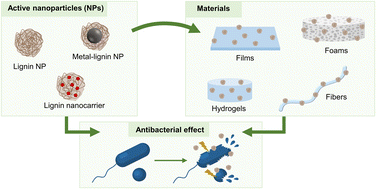Antibacterial lignin-based nanoparticles and their use in composite materials
Abstract
Lignin, one of the most abundant biopolymers on earth, has been traditionally considered a low-value by-product of the pulp and paper industries. This renewable raw material, besides being a source of valuable molecules for the chemical industry, also has antioxidant, UV-absorbing, and antibacterial properties in its macromolecular form. Moreover, lignin in the form of nanoparticles (LigNPs) presents advantages over bulk lignin, such as higher reactivity due to its larger surface-to-volume ratio. In view of the rapid surge of antimicrobial resistance (AMR), caused by the overuse of antibiotics, continuous development of novel antibacterial agents is needed. The use of LigNPs as antibacterial agents is a suitable alternative to conventional antibiotics for topical application or chemical disinfectants for surfaces and packaging. Besides, their multiple and unspecific targets in the bacterial cell may prevent the emergence of AMR. This review summarizes the latest developments in antibacterial nano-formulated lignin, both in dispersion and embedded in materials. The following roles of lignin in the formulation of antibacterial NPs have been analyzed: (i) an antibacterial active in nanoformulations, (ii) a reducing and capping agent for antimicrobial metals, and (iii) a carrier of other antibacterial agents. Finally, the review covers the inclusion of LigNPs in films, fibers, hydrogels, and foams, for obtaining antibacterial lignin-based nanocomposites for a variety of applications, including food packaging, wound healing, and medical coatings.

- This article is part of the themed collections: Celebrating nanoscience in Spain, Popular Advances and Recent Review Articles


 Please wait while we load your content...
Please wait while we load your content...